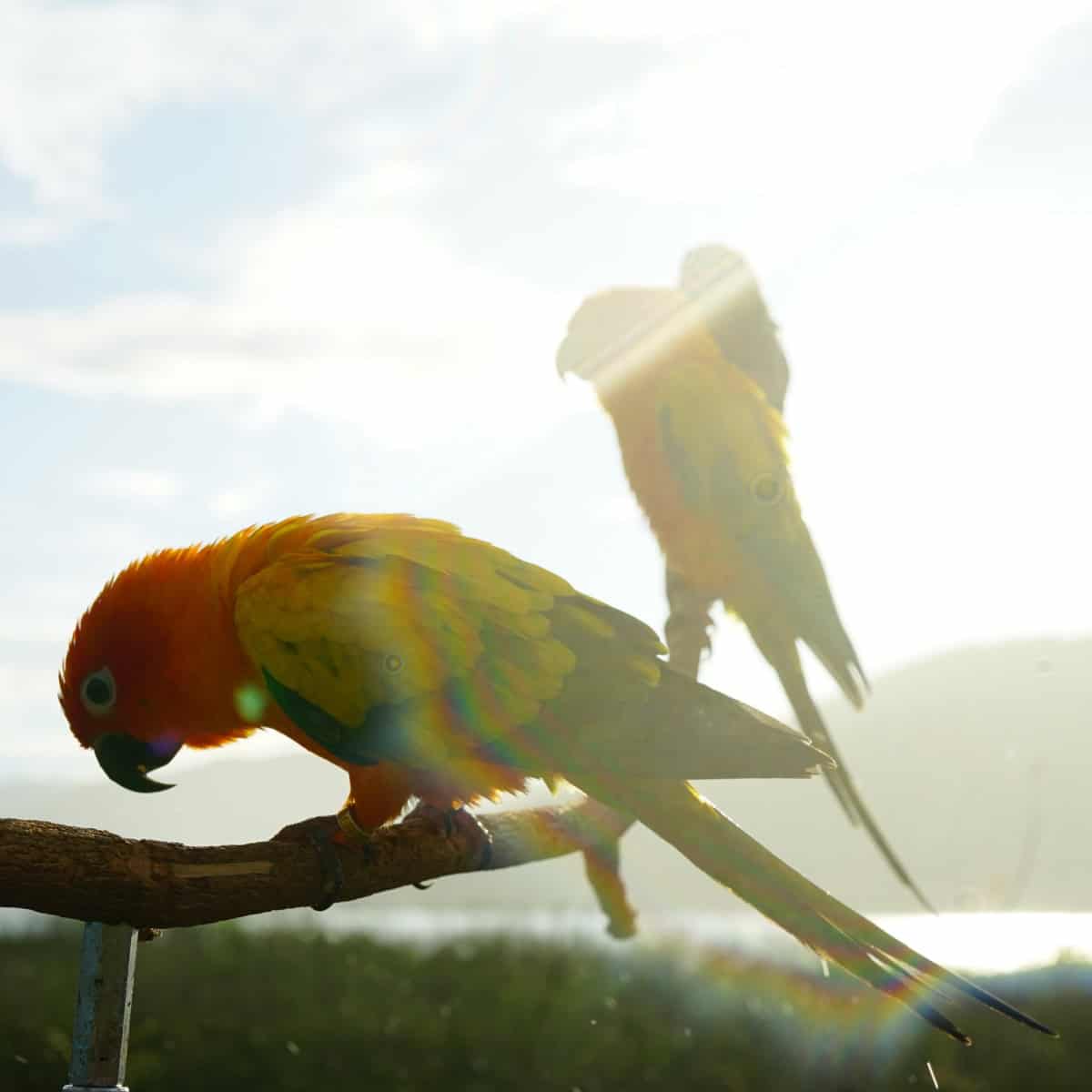
Is There a Relationship Between Sunlight and Vitamin D in Birds?
Last Updated on by Mitch Rezman
Scientific research on the relationship between sunlight and Vitamin D production in birds has provided valuable insights into how birds synthesize Vitamin D3 and its importance for their health.
Here are some key studies and findings:
- **Studies on UV Light and Preen Gland Oil**:
– Researchers have investigated the role of the uropygial gland and its secretions in Vitamin D synthesis. A study by K. H. Norris in 1970 demonstrated that the preen gland oil of birds contains a precursor to Vitamin D3, which is converted to active Vitamin D3 when exposed to UVB radiation from sunlight.
– The conversion process was detailed in a study by P. E. W. Adams and D. A. Hewison in 1982, showing the biochemical pathways involved in the transformation of the precursor to active Vitamin D3.
- **Effects of UVB Exposure on Calcium Metabolism**:
– Research by F. W. Qualls and H. M. Shine in 1985 explored how UVB exposure affects calcium metabolism in birds.
The study found that birds exposed to adequate UVB light had better calcium absorption and stronger bone development compared to those deprived of UVB light.
– A study by M. T. Oonincx et al. in 2010 further confirmed that UVB light is essential for the synthesis of Vitamin D3, which in turn is crucial for maintaining proper calcium levels and overall bone health in birds.
- **Impact on Reproductive Health**:
– Studies have also examined the impact of Vitamin D3 on reproductive health in birds. Research by A. M. Paganelli et al. in 1987 showed that female birds with sufficient Vitamin D3 levels produced eggs with stronger shells, highlighting the importance of sunlight exposure for breeding birds.
– The role of Vitamin D3 in embryonic development was studied by B. T. Backhouse and R. W. Clark in 1996, showing that adequate levels of this vitamin are critical for the proper development of avian embryos.
- **Behavioral and Physiological Studies**:
– Behavioral studies, such as those conducted by J. M. Marzluff and P. W. Mooney in 1995, have shown that birds actively seek out sunlight and engage in sunbathing behaviors, which is believed to be linked to their need for UV exposure for Vitamin D3 synthesis.
– Physiological research, like the work of C. M. Handel and J. A. Nagy in 2000, has demonstrated that birds with limited access to natural sunlight show signs of Vitamin D deficiency, including weakened bones and poor health.
These studies collectively underscore the critical role of sunlight in the production of Vitamin D3 in birds and its subsequent effects on their overall health, reproduction, and behavior.
Research on sunlight and vitamin D production in birds has established a strong link between the two. Here’s a quick rundown of some key findings:
- Sunlight as the Primary Source: Studies show that sunlight, particularly UVB rays (285-315 nm wavelength), is the most important source of vitamin D for birds [1, 2, 3]. Their skin, especially featherless areas like legs and around the eyes, contains precursors that UVB rays convert into vitamin D3.
- Birds synthesize Vitamin D themselves: Similar to humans and other mammals, birds don’t rely solely on dietary intake for vitamin D. Their body has the natural ability to produce it when exposed to UVB light.
- Quantity of Sunlight Exposure: Research suggests that exposure durations ranging from 11 to 45 minutes per day under unfiltered sunlight can be sufficient for birds like chickens. Ideally, an hour of direct sunlight a day is recommended for optimal vitamin D production.
- Importance for Captive Birds: Window glass filters out UVB rays, rendering sunlight exposure through windows ineffective for vitamin D synthesis in captive birds. This necessitates alternative solutions like UVB light bulbs designed specifically for avian use.
Impact on Bird Health: Adequate vitamin D levels are crucial for various bodily functions in birds, including calcium metabolism, bone health, and overall well-being. Vitamin D deficiency can lead to health problems in captive birds.
In a riveting exploration that sheds light on the impact of ultraviolet B (UVB) radiation on the intricate dance of calcium metabolism in our feathered companions, M Stanford et al. embarked on a pioneering study focused on the elegant and intelligent residents of the avian world, the grey parrots (Psittacus erithacus).
This study carved out a path to understanding how these majestic creatures, known for their vibrant plumage and keen intelligence, navigate the subtle nuances of vitamin and mineral absorption under the influence of UVB radiation.
Venturing into the heart of this investigation, the researchers divided their avian subjects into two cohorts, each consisting of 20 robust and healthy grey parrots.
The division was based on their dietary regimens: one group was nourished on a traditional seed-based diet, echoing the diets of their wild counterparts, while the other group was fed a scientifically formulated pellet-based diet, designed to provide a balanced nutritional profile.
The stage was set to observe the effects of UVB radiation, spanning wavelengths from 285 to 315 nm, on these two dietetically distinct groups.
The results of this compelling study were nothing short of remarkable. Across the board, regardless of their dietary foundations, both groups of grey parrots showcased a significant uptick in the plasma levels of ionized calcium upon exposure to UVB radiation. This discovery illuminated a critical aspect of avian biology, underscoring the intrinsic ability of UVB radiation to bolster calcium metabolism, independent of the dietary sources of calcium and vitamin D3.
Interestingly, a distinct divergence emerged when examining the levels of 25-hydroxycholecalciferol, a pivotal marker of vitamin D3 status.
Here, the seed-fed parrots stood apart, revealing a notable increase in this vitamin marker, a testament to the transformative power of UVB radiation in converting dietary precursors into this essential nutrient.
In contrast, such an elevation was not observed in their pellet-fed counterparts, hinting at the multifaceted interplay between diet, sunlight, and nutrient metabolism.
Further enriching this narrative, a separate vein of the study cast its gaze upon 28 South American beauties of the genus Pionus, basking in the unadulterated glory of natural sunlight between the bustling months of March and August.
Intriguingly, this exposure to the unfettered embrace of the sun did not manifest in significant increases in plasma ionized calcium or 25-hydroxycholecalciferol, adding a layer of mystery and prompting further contemplation about the unique responses of different avian species to sunlight.
This study, in essence, serves as a canvas, painting a vivid picture of how UVB radiation acts as a maestro, orchestrating the symphony of calcium metabolism in psittacine birds. It unravels the enigmatic relationship between sunlight and the physiological needs of these avian beings, providing a beacon of insight for veterinarians, avian caretakers, and enthusiasts alike.
It echoes the importance of tailored care and environmental enrichment for these feathered jewels, ensuring their vibrance and vitality in captivity mirrors that of their wild brethren.
Thus, the study by M Stanford et al. stands not only as a hallmark of scientific exploration but as a testament to the interconnectedness of life, light, and well-being in the avian world.
Written by Mitch Rezman and the Windy City Parrot Content Team
Author Profile
Latest entries
 The Traveling BirdJune 26, 2025Can You Name 5 Parrot Species That Are Living Wild in the USA?
The Traveling BirdJune 26, 2025Can You Name 5 Parrot Species That Are Living Wild in the USA? Bird BehaviorJune 26, 2025How is it Parrots Are Problem Solvers Social Animals and Even Use Tools?
Bird BehaviorJune 26, 2025How is it Parrots Are Problem Solvers Social Animals and Even Use Tools? Bird & Parrot AnatomyJune 25, 2025How a Tiny Chemical Modification Makes Parrots Nature’s Living Paintings
Bird & Parrot AnatomyJune 25, 2025How a Tiny Chemical Modification Makes Parrots Nature’s Living Paintings PigeonsJune 20, 2025How Do Parrots Thrive in Cities Outside Their Native Habitats?
PigeonsJune 20, 2025How Do Parrots Thrive in Cities Outside Their Native Habitats?


